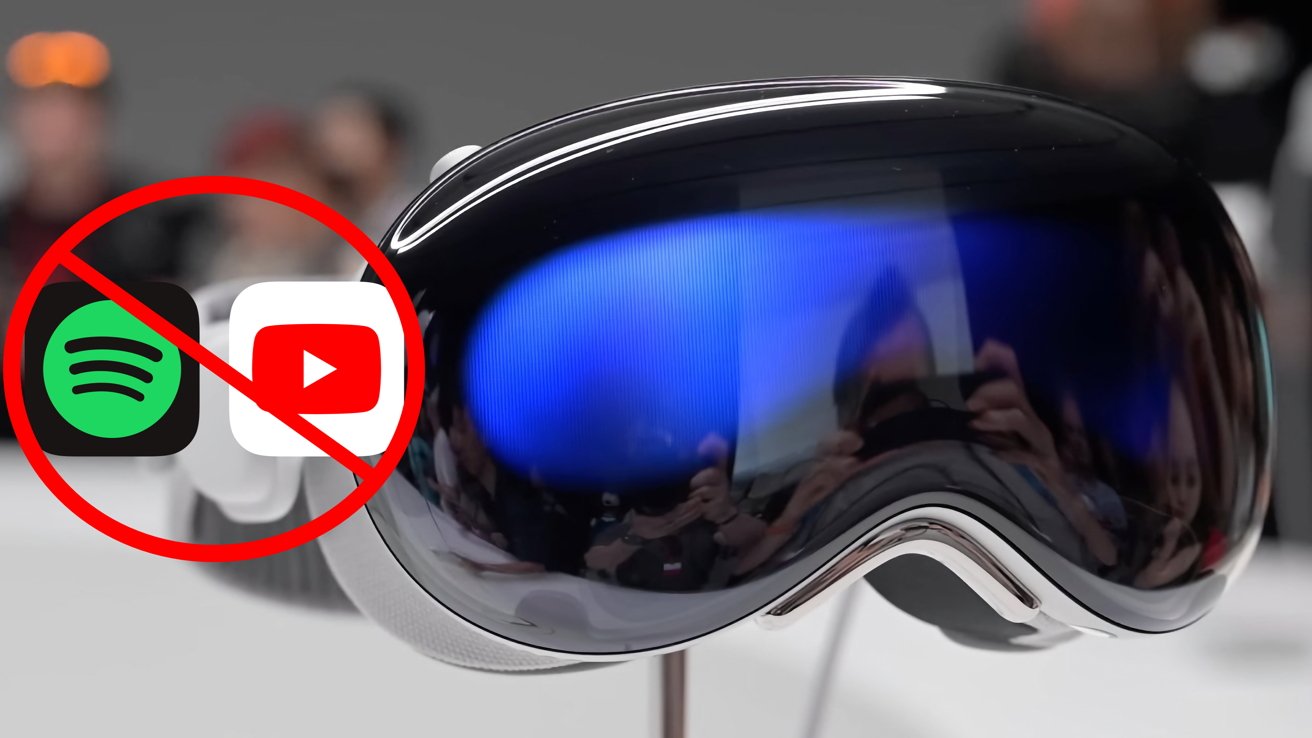YouTube and Spotify also won't offer any apps on Apple Vision Pro
Like Netflix, YouTube and Spotify won't be building specialized apps for Apple Vision Pro, nor will they allow their iPad apps to run on the hardware.

YouTube and Spotify aren't coming to Apple Vision Pro
Some of the world's biggest corporations are taking a wait-and-see approach with Apple's new hardware, declining to offer any support for apps. Netflix was first to confirm that no native or iPad ported app would come to Apple Vision Pro, and now two more prominent companies join the mix.
According to a report from Bloomberg, both YouTube and Spotify have confirmed that their apps will not be available on Apple Vision Pro. The companies recommend users visit their websites in Safari instead.
Spotify, YouTube, and Netflix make up the world's biggest streaming services. However, it isn't clear whether their apps missing from the platform will cause potential buyers to bypass the platform.
Since Apple Vision Pro is an expensive product starting at $3,499 that serves a small niche of use cases, the customers buying the device won't miss those services. It is likely that developers and Apple fans will be first in line, both of which likely already use competing Apple platforms like Apple TV+, Apple Podcasts, and Apple Music.
Most other third-party streaming services are embracing Apple Vision Pro with at least a port of the iPad app. The Disney+ app is launching on the platform with full 3D environments to watch content from, like on Tatooine or the Scare Floor.
The news isn't exactly a surprise, as Google is usually slow, if defiant, about adopting new Apple platforms or features. Spotify is in a similar situation, except it is generally more openly hostile towards Apple and its business models.
Apple Vision Pro is available for pre-order on January 19, starting at $3,499. It ships to customers on February 2.
Read on AppleInsider

Comments
but no YouTube tbh is a bit of a bummer
but that’s what you get as an early adopter
But why is Spotify opposed to Apple products? Hardly makes sense to limit your customer base.
The premium version going for pre-sale tomorrow (Vision Pro model) allows Apple to get their most impressive version out and start turning heads. They move 75k units by 2/2/24 and keep making more. They have already started tapping into the biggest war-chest that has ever existed for advertising, and one of the largest, well thought out marketing blitz that has ever existed is launched on the same day pre-orders go live.
For the rest of the year, they continue to sell Vision Pro units as fast as they can make them. They meanwhile continue to apply the finishing touches to a more “budget” version of the platform that doesn’t offer the EyeSight feature, has a slightly less impressive experience, and fewer premium materials, making them far faster and cheaper to produce. They are also lighter and have improved power-supply/battery options. By this time, Apple has spent approaching $5 billion across their product lines for advertising, with the Vision Pro budget edging out iPad and Mac product lines, and falling short only of the iPhone line. Every ad demonstrates slick and jaw-dropping technology and application that feels like it could only exist in science fiction.
Meta and other competitors disparage the Vision and make the claim that they offer a similar experience and support the MetaVerse; They constantly point out that the MetaVerse is the next big thing and is not supported by Apple. No-one cares, and demand for the Apple platform continues to grow; people want something that is here now, and Meta missed their opportunity. The most popular third parties have taken sharp notice, and have started to introduce support.
After a year of increasingly pent-up demand that is now barely containable, Apple announces the new Apple Vision in September, starting at $1499 for the basic experience (which is excellent), with available options that can push the price as high as $2799, with the average order topping $2100. They also announce that these will be in consumers hands before Christmas. Sales explode.
Independent developers publish apps to encapsulate the video services, but these are an inferior experience, yet still intensely popular. By the following February, YouTube, and Netflix have released 1st party apps for Apple Vision, claiming this is the future and they are in it for the long haul! Spotify drags their feet because they cannot find a formula to adequately differentiate their product in this new marketplace.
Apple quietly looks over to YouTube and Netflix, and utters, “POW! How’d you like me now?”
LOL
ITS BUSINESS.
The ROI just isn’t there for headsets.
Buried in the Vision Pro streaming announcements. IMAX app. I can't find anything that says what that is.
Those things will hold the VP back much more than the availability of native streaming apps, especially ones where you can already access from their website.
No it doesn't. Higher resolutions are often app dependant and browser will be massively inferior if anyone plans on using the VP while travelling, which has been mentioned by some as a use case. You need the download and offline viewing, which is enabled by the app.
2) If it's not corporate spite — which Netflix, Spotify, and Google have toward Apple — then why was Netflix's iPad app working on AVP previously and then Netflix took the added effort, albeit minor, to disable it being allowed to run on the device? Why do you think it's good business for any of those companies to not allow something they've already made and that is already idealized for touch input to not run on Apple's new product? The reason is simple and clear. They are jealous of Apple and this will hurt the AVP experience more than it will hurt their user ship... and yet, I have a feeling Apple will prevail and you'll be eating crow once again.